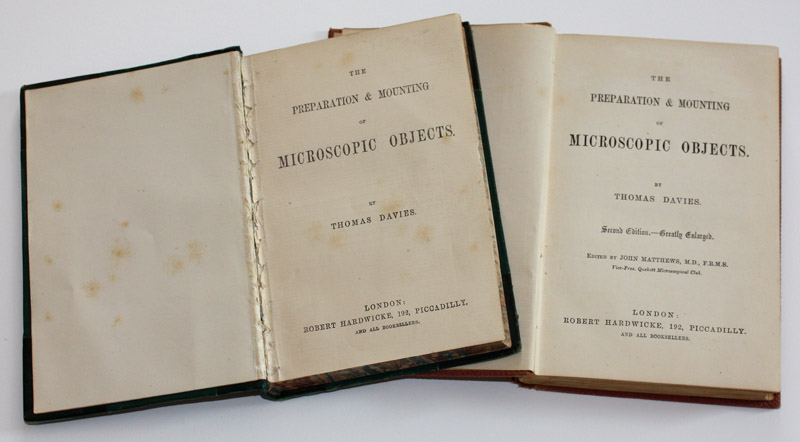
Figure 1. Title pages of the first (1863) and second (1873) editions of The Preparation and Mounting of Microscopic Objects, by Thomas Davies.
Thomas Davies, ca. 1831-1876
by Brian Stevenson
last updated March, 2012

Figure 1. Title pages of the first (1863) and second (1873) editions of The Preparation and Mounting of Microscopic Objects, by Thomas Davies.
Thomas Davies wrote The Preparation and Mounting of Microscopic Objects, one of the first books of methods for preparing microscope slides, in 1863 (Fig. 1). The following essay presents information indicating that this great book has been incorrectly attributed to the wrong man, along with evidence supporting attribution to a previously overlooked microscopist.
The Transactions of the Microscopical Society of London described Davies’ book as “a complete repertory of all that concerns the subject upon which it treats. The directions are given in a clear and precise manner, and the mode of manipulation required for different classes of objects is judiciously stated. Upon the whole, we may say that it is the best and most complete work on the subject with which we are acquainted, and one that will be found extremely useful to all engaged with the microscope”. A second, expanded edition of was published in 1873. That edition was edited by John Matthews, Fellow of the Royal Microscopical Society and then-Vice President of the Quekett Microscopical Club. The Preparation and Mounting of Microscopic Objects was reprinted numerous times, well into the 20th century. Both the first and second editions are available from Google Books (access varies by country). Hardbound copies of the first edition are scarce and usually expensive, while the second edition is more readily obtained from antiquarian booksellers, often at reasonable prices. As with everything else in collecting, surpringly good deals are occasionally found - I acquired a very good copy of the first edition for only $25 (US) in 2012.
It has long been assumed that the book’s author was a London-based mineralogist named Thomas Davies, who lived from 1837 to 1892. This attribution dates back to at least 1891, when Allibone's Critical Dictionary of English and American Authors described the geologist as having been the author (Figure 2). Whoever compiled the entry for Davies did not research the topic very well, as it contains at least one obvious falsehood. The mineralogist was born in the parish of St. Pancras, London, not in Warrington. There are no indications that this Davies ever lived in Warrington, which is located between Liverpool and Manchester, England. As discussed below in greater detail, the author of The Preparation and Mounting of Microscopic Objects was definitely from Warrington.

Figure 2. Entry for Thomas Davies in Allibone's Critical Dictionary of English and American Authors, 1891.
Other sources strengthen the argument that the mineralogist Thomas Davies was not the author of The Preparation and Mounting of Microscopic Objects (Figures 3 and 4). Significantly, descriptions of the mineralogist that were written by people who knew him did not mention the microscopy book. In fact, he was described as “not a copious writer” and that “his published work was not voluminous; it relates almost exclusively to the microscopic characters of the pre-Cambrian rocks” (Figures 3 and 4, highlighted sections). It is impossible to believe that Davies’ colleagues would neglect to mention that he was the author of a famous book on microscopy.
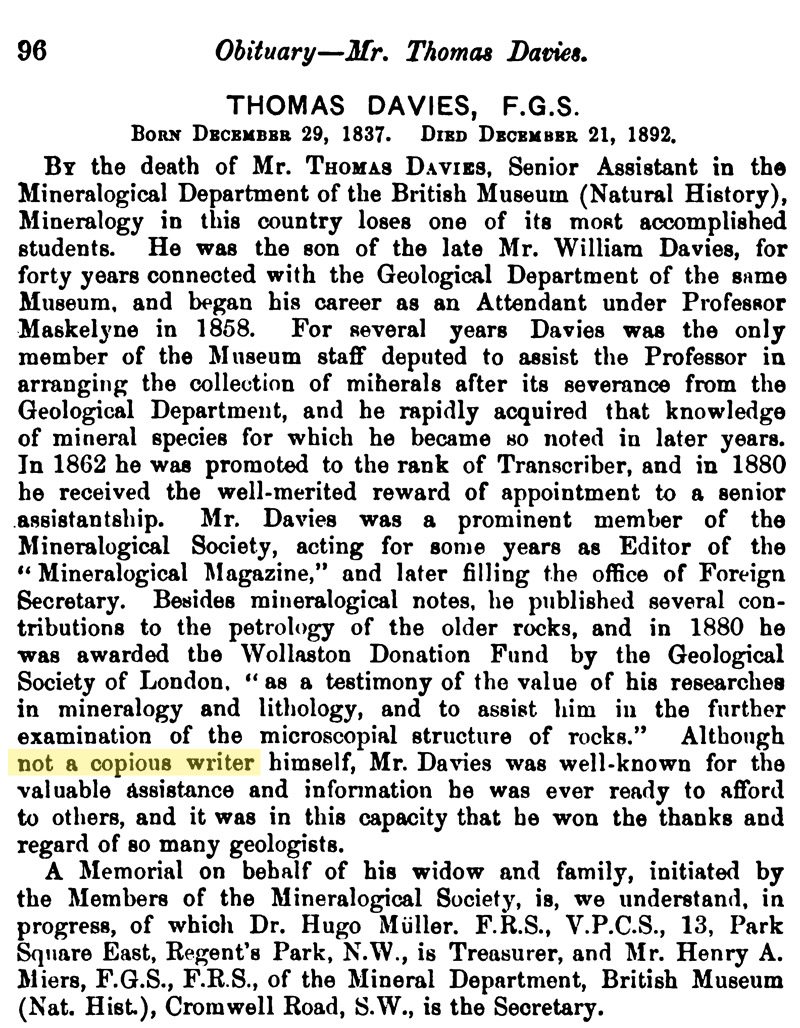
Figure 3. Obituary of Thomas Davies, mineralogist, from ‘The
Geological Magazine’, 1893. The highlighted text emphasizes that his colleagues
did not consider Davies to be a copious writer.
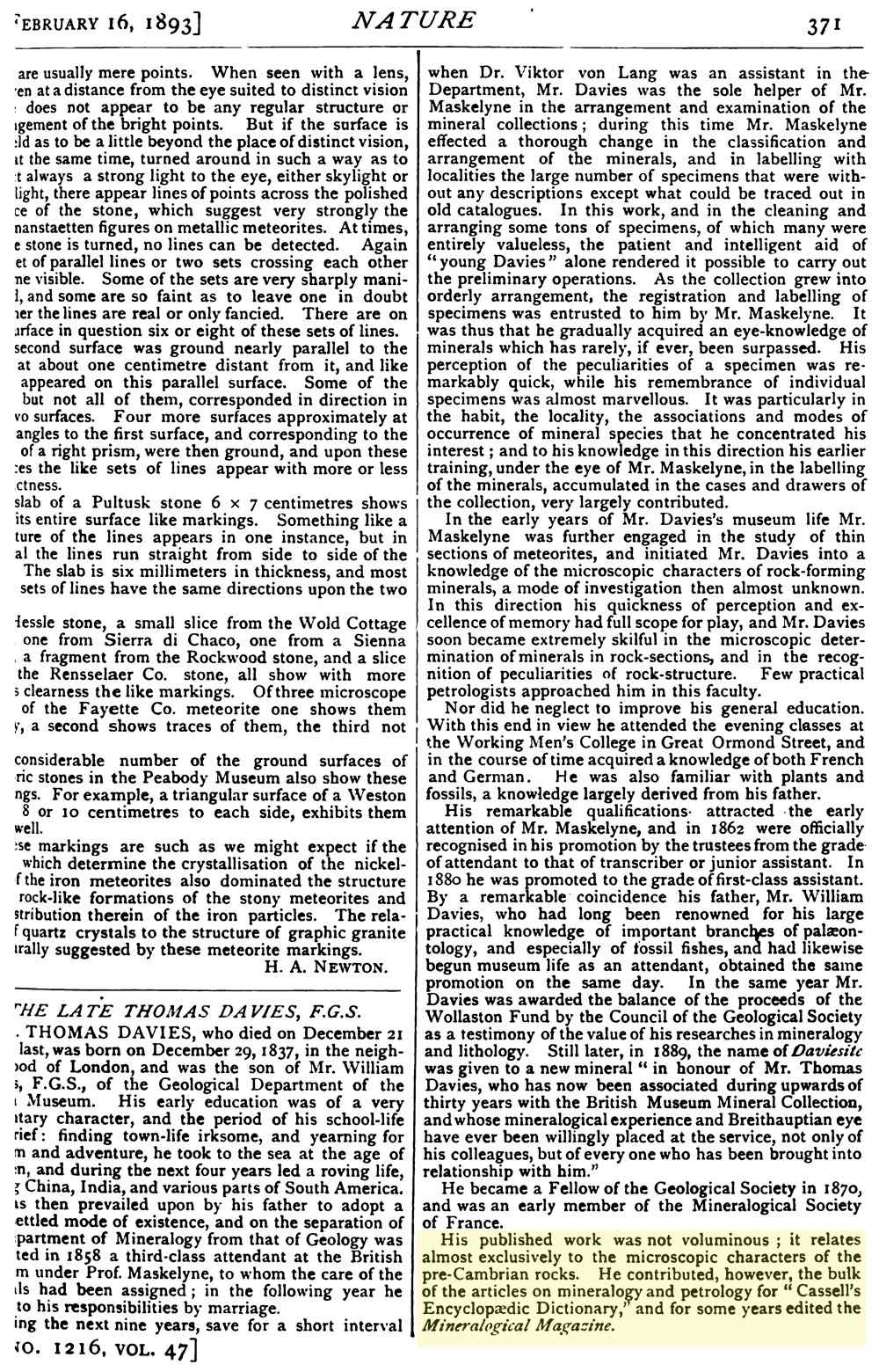
Figure 4. Obituary of the mineralogist Thomas Davies, from
‘Nature’, 1893. The highlighted text stresses that Davies was not a voluminous
writer. Note that this extensive biography makes no mention of the Davies’
microscopy book, an absence that also argues against the possibility that the
mineralogist was the book’s author.
Having discounted the London mineralogist, who was the true author of The Preparation and Mounting of Microscopic Objects? An important clue comes from the book’s second edition, published in 1873. Davies’ preface to the first edition was reprinted, with the addition of his residence: Warrington (Figure 5). Census records indicate that two men named “Thomas Davies” lived in the vicinity of Warrington in 1861: a 49 year-old “brazier” (brass worker) and a 30 year-old “gentleman”. The 1871 census recorded the brazier as being “retired”, and the now 40 year-old gentleman still living with his mother, elder brother and a servant.
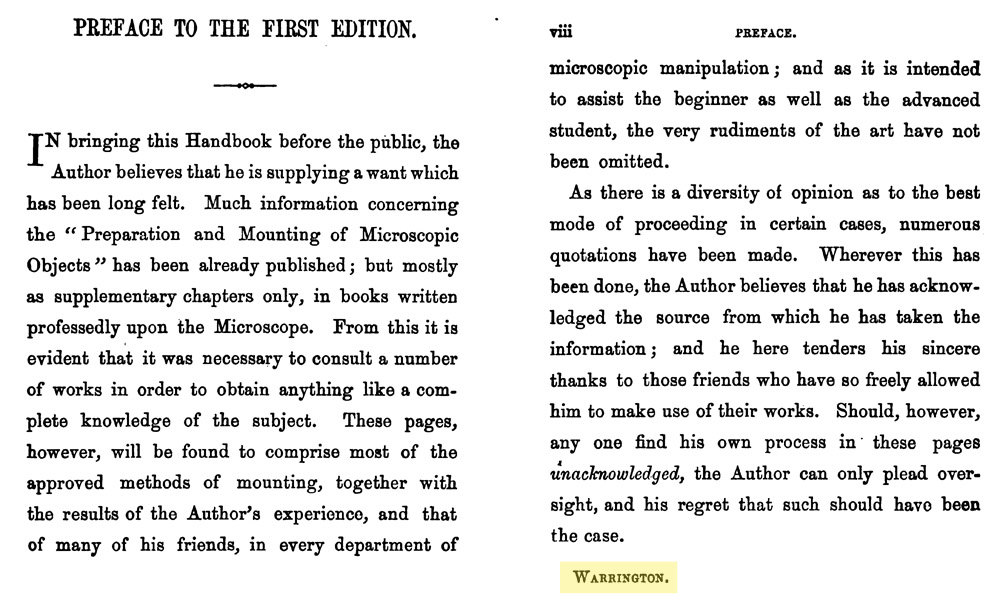
Figure 5. From the second edition of ‘The Preparation and
Mounting of Microscopic Objects’. Davies’ address of Warrington is highlighted.
The following review, which appeared in the Royal Microscopical Society’s Monthly Microscopical Journal, summarizes the second edition, plus provides some more insights into the author:
“The Preparation and Mounting of Microscopic Objects. By Thomas Davies. 2nd Edition (enlarged). Edited by John Matthews, M.D., F.R.M.S., Vice-President Quekett Microscopical Club. London: Hardwicke. - This little book, which has in our language no rival whatever, has made its appearance in a new edition, the former one having been about ten years in existence, and being hence somewhat behind the time. And in its new form it contains more than fifty pages of entirely new matter, and has an additional chapter by the present Editor, Dr. Matthews, who in it explains seriatim the various novelties in mounting and otherwise preparing objects, which have been devised both in the countries of our own language and upon the Continent; and indeed, for our own part, we consider this chapter of the greatest value to the amateur, who has frequently insufficient knowledge of languages to enable him to consult German or French authorities; and even if he had, has no opportunity of perusing these books themselves. For this reason we think, too, that the editor would have done well had he introduced a chapter on the subject of immersion lenses, and explained fully the mode of using these objectives, their several prices, and the best mode of procuring them. We think, too, that he would have done better had he introduced more matter on the subject of the preparation of purely anatomical objects. We fear that on account of this absence from the work of special advice on the mounting of the several specimens, which alone interest the medical student, the book will not appeal as fully as it ought to a very large class - now in fact a special society - of microscopic workers.
But in all that refers to the wants of the ordinary workers at the microscope, the book will be found amply full, and that too of really useful materials; for we find that both author and editor have been careful not merely to collect together facts, but to discriminate so that only the useful hold a place in these pages. We may mention a few of the authors quoted in this volume, to show how the editor has taken pains with his work. There are Dr. Beale, Mr. T.K. Parker, Dr. Carpenter, Dr. Klein, Dr. Alcock, Dr. Lockhart Clarke, Dr. Bastian, Mr. L.G. Mills, Mr. Edwards (New York), Herr Hyrtl, Mr. Mclntire, Professor Williamson, Mr. Moseley, Mr. Dancer, Mr. Suffolk, Mr. Hislop, Mr. T.G. Rylands, and many others. The chapter on polariscopy, too, exhibits a great improvement on that in the former edition. The author has given fully and clearly the necessary information on this interesting section of microscopic work. We should have wished the authors had the sundry references to either of the Microscopical Journals more accurately given. When the work was first published, but one Microscopical Journal existed; but now there are two, so that a reference to the Microscopical Journal leaves the reader absolutely no clue as to which of the two magazines is referred to. We are, indeed, once referred to under our proper title, but that is all that we have been able to observe. And now, if we have found fault, it must not be supposed that we have further complaint to make. We have cited all the points to which we object, but not a tittle of those of which we cannot but approve; and that we think is enough to show what an immensely improved edition is that which has made its appearance under the skilful care of Dr. John Matthews.”
Additional records exist regarding Thomas Davies, microscopist of Warrington, as he was active in the Microscopical Section of the Manchester Literary and Philosophical Society. The Preparation and Mounting of Microscopic Objects contains numerous personal references to other members of the Manchester-area microscopist community. Davies of Warrington had a great interest in chemical crystals and polarized light, so it no surprise that the RMS review of his book noted the strong polariscopy section.
The Quarterly Journal of Microscopical Science reported that during the October 21, 1861 meeting of the Microscopical Section of the Manchester Literary and Philosophical Society, “The Secretary exhibited a specimen of the compound salt of magnesia and copper, prepared by Mr. Thomas Davies, of Warrington. Doubts having been expressed if it were a true compound salt, or a mere mechanical mixture, Mr. Dale, who at the Secretary's request had prepared some of the salt, undertook to report further upon it. Some forms of crystal were exhibited, producing novel effects by polarised light.”
At the February 17, 1862 meeting, “The Secretary read a Paper, by Mr. Thomas Davies of Warrington on Crystallization. Mr. Davies treats more particularly upon some of the double salts, which show beautiful combinations of form and colour by polarized light; and upon his method of obtaining determinate flower-like, forms, surrounded by a film of the uncrystallized salt. The novelty of the author's system, consists in the following particulars: He makes a nearly saturated solution, say of the double sulphate of copper and magnesia; he dries rapidly a portion on a glass slide, allowing it to become so hot as to fuse the salt in its water of crystallization; there then remains an amorphous film on the hot glass. On allowing the slide to cool slowly, the particles of the salt will absorb moisture from the atmosphere, and begin to re-arrange themselves on the glass, commencing from points. ‘If then placed under the microscope,’ says the author, ‘we shall see points starting up here and there, and from those centres the crystals may be watched as they burst into blossom, and spread their petals on the plate.’ Starting points may be made at pleasure by touching the film with a fine needle, to enable the moisture to get under it; but this treatment renders the centres imperfect. If allowed to go on, the crystals would slowly cover the plate, or if breathed upon they form immediately; whereas, if it is desired to preserve the flower-like forms on a plain ground, as soon as they are large enough, development is suspended, by again applying gentle heat; the crystals are then covered with balsam and thin glass, to be finished off as usual. The balsam must cover the edges of the film, or moisture will probably get under it, and crystallization go creeping on. Many crystals which produce similar forms cannot be preserved in balsam; in the hyposulphite of soda they are very fine, and the author is endeavouring to preserve them in castor oil. Mr. Sidebotham referred to the vegetable forms produced by Mr. Petschler, with bichromate of potash in gelatine, exhibited at the British Association Microscopical Soiree. Since then flower-like shapes had been obtained from nitrate of silver amongst the ramifications of the bichromate; as it is an interesting subject, he should endeavour to bring it before the next meeting.” Thomas Davies described how to prepare this mixture of magnesium and copper sulphates on pages 76-77 of his book's first edition, using many of the same phrases.
A report of the May 19, 1862, annual meeting of the Microscopical Section of the Manchester Literary and Philosophical Society noted that, during the previous year, there were presentations of “A paper by Mr. Thomas Davies, of Warrington, upon ‘Crystallization,’ in which he describes his method of obtaining flower-like forms in fused films of certain salts, by graduated reabsorption of moisture from the atmosphere”, and “A paper by Mr. Thos. G. Rylands, of Warrington, ‘On the classification of the Diatomaceae,’ in which the author enlarges upon the necessity of a reconstruction of the system of nomenclature,&c.”
Thomas Glazebrook Rylands (1818-1900) owned a wire manufacturing business in Warrington, and served the town as mayor and alderman. He is most famous for his many contributions to the studies of diatoms. He communicated with the other diatom experts of his time, including Walker-Arnott, Greville, Hooker and Ralfs. Robert Kaye Greville (1794-1866) left his entire collection of diatom slides, plus some 700 bottles of specimens, to Rylands. He also investigated and wrote on other fields, including ferns, entomology, meteorology, geology and astronomy. On page 33 of the first edition of The Preparation and Mounting of Microscopic Objects, Davies described Rylands as “my friend”. That Davies was a colleague of Rylands, and that Rylands operated a wire-making business, are additional clues toward identifying Davies.
Thomas Davies published papers on crystals and polariscopy in The Quarterly Journal of Microscopic Science, in 1863 and 1865. The 1863 paper was entitled “The photography of magnified objects by polarized light”. That description of his interest in photography suggests that our Mr. Davies was also the Thomas Davies of Warrington who displayed stereoscopic landscape transparencies at the 1861 Photographic Society of Scotland exhibition in Edinburgh.
As evidenced by his book, Davies’ expertise in microscopy extended far beyond crystallization of salts and polaroscopy. Another example comes from an 1863 report by Davies and J.G. Dale “On Transparent injections” to the Microscopical Section of the Manchester Literary and Philosophical Society, “After enumerating the various desiderata of a transparent injecting fluid, it was observed that soluble colouring matters failed to fulfill them, owing to the action of endosmos, causing them merely to dye the tissue sought to be injected. This defect is shown to be remedied by the use of insoluble colouring matters in an exceedingly fine state of subdivision, which can only be prepared by precipitation under constant agitation, and the following recipe is stated to succeed admirably, showing vessels of 1/2000 of an inch, with a clear outline even under a 1/3 objective, without any grain or extravasation of the colouring matter: - Take 180 grains best carmine, 1/2 fluid oz. ammonia, com. strength, SG 0 92, or 15 degrees ammonia meter, 3 to 4 oz. distilled water. Put into a small flask, and allow to digest without heat 24 to 36 hours, or until the carmine is dissolved. Then take a Winchester quart bottle, and with a diamond mark upon it the spot to which 16 oz. of water extend. The coloured solution must then be filtered into the bottle, and to this pure water must be added until the whole is equal to 16 oz. Next dissolve 600 grains in potash alum in about 10 fluid oz. of water, and add to this under constant boiling a solution of carbonate of sodium, until a slight permanent precipitate is produced. Filter and add water up to 16 fluid oz. Boil, and add this solution while boiling to the cold ammoniacal solution of carmine in the Winchester quart, and shake vigorously for a few minutes. A drop now placed upon white filtering paper should show no colouring ring; should it do so, the whole must be rejected. Supposing the precipitation to be complete or very nearly so, shake vigorously for half an hour, and allow to stand till quite cold; the shaking must then be renewed, and the bottle filled up with cold water. After allowing the precipitate to settle for a day, draw off the clear supernatant fluid with a syphon. Repeat the washing till the clear fluid gives little or no precipitate with chloride of barium. So much water must be left with the fluid that at last it must measure 40 fluid oz. For the injection fluid take 24 oz. of the above coloured fluid, and 8 oz. of good gelatine, allow these to remain together all night, then dissolve by the heat of a water bath, after which it should be strained through fine muslin. On injecting, the ordinary precautions for a gelatine injection are alone necessary.”
Davies’ first edition included the above description of preparing injected tissues, on pages 138-139. That section begins “.. Mr. J.G. Dale, F.C.S., and I have made numerous experiments with carmine injection, and have at length been favoured with what we deem success”.
Around 1872, his publisher approached Thomas Davies with a proposition to revise The Preparation and Mounting of Microscopic Objects for a second edition. Davies was then in poor health, and could not undertake the job. John Matthews was enlisted to revise the book, using both Davies’ notes and his own experience in microscopy.
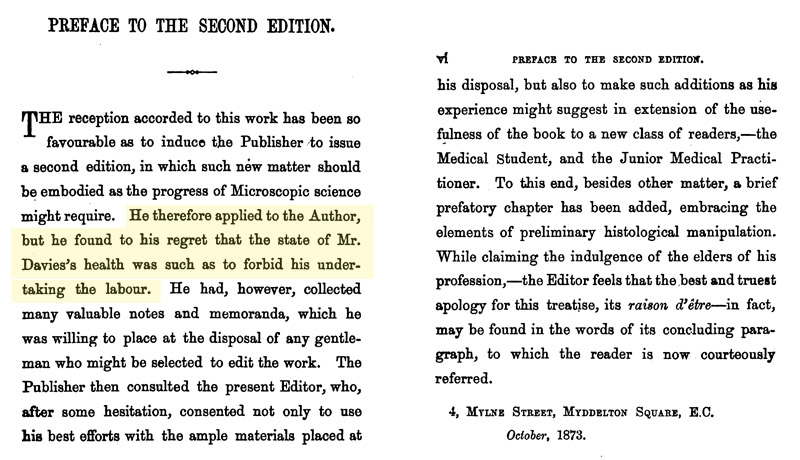
Figure 6. John Matthews’ preface to the second edition of The
Preparation and Mounting of Microscopic Objects. The highlighted sentence
indicates that Thomas Davies was in very poor health in the early 1870s,
necessitating the services of an editor to put together the second edition.
Editor John Matthews (1813-1886) was a member of the Quekett Microscopical Club, and served as Vice President, so had experience in many aspects of
microscopy. Also, being an MD, Matthews would have been a good choice to write
on microscopy topics appropriate for medical students and practitioners.
Davies’ health in the early 1870s further helps identify our author. Recall that two men named Thomas Davies lived in Warrington during 1861 and 1871, a brazier and a gentleman. The brazier died in 1888, at the age of 77. The gentleman was not recorded anywhere in the censuses from 1881 or later, suggesting that he had died by 1881. The gentleman’s mother died in 1875, and his elder brother moved away from Warrington by 1881. A Thomas Davies died in Warrington on June 27, 1876, of “diabetes mellitus, phlegmonius erysipilas and pyoemia”. He was reported to have been 44 years old, fitting the census records of the gentleman Thomas Davies. Diabetes was not treatable in the 1870s, so a patient could only suffer the disease’s debilitating symptoms, which could last for years. The “phlegmonius erysipilas and pyoemia” indicate an infection that was probably the ultimate cause of death. Moreover, this Thomas Davies had been the manager of Hope Iron, Steel and Wire, a wire-making facility.
Putting all of this information together, it is highly probable that the author of The Preparation and Mounting of Microscopic Objects was the Thomas Davies who died in 1876. That man’s diabetes mellitus (type 1 diabetes) would account for the ill health reported by the author. The only other Thomas Davies known to have lived in Warrington when the book was published died more than a decade later, at a ripe age. Microscopist Thomas Davies was a colleague of Thomas Rylands, an important political figure in Warrington and owner of a wire-making business. Such a connection could have easily obtained a job for Davies after his mother died and employment became necessary. Finally, the brazier was working class, whereas the gentleman had no occupation in either 1861 or 1871, and lived with his mother (a “proprietor of houses” who lived on “income”, according to the censuses). The gentleman was far more likely than the brass worker to have the time and money to indulge in microscopy, book-writing, and travels to Manchester for meetings. And much more likely to have associated with a wealthy industrialist and politician like Rylands.
Acknowledgements
Many thanks to Howard Lynk and Peter Paisley for numerous discussion on Davies and other microscopy topics.
Resources
Bracegirdle, Brian (1998) Microscopical Mounts and Mounters, Quekett Microscopical Club, London, page 30
Davies, Thomas (1863) The Preparation and Mounting of Microscopic Objects, Hardwicke, London
Davies, Thomas (1863) The photography of magnified objects by polarized light, Quarterly Journal of Microscopical Science, New series, Vol. 3, pages 201-203
Davies, Thomas (1865) Crystallization and the microscope – No. II, Quarterly Journal of Microscopical Science, New series, Vol. 5, pages 205-212
Davies, Thomas, and John Matthews (1873) The Preparation and Mounting of Microscopic Objects, Second Edition, Hardwicke and Bogue, London
Death record of Thomas Davies (1876) Warrington district, Cheshire county, Vol. 8c, page 105
Dictionary of National Biography (1901) Thomas Davies, page 118
Edinphoto (accessed February, 2012) Information on the 1861 exhibition of the Photographic Society of Scotland, http://www.edinphoto.org.uk/3/3_pss_exhibitions_5th_feb_1861.htm
England birth, death and census records, accessed through ancestry.co.uk
Geological Magazine (1893) Obituary of Thomas Davies, Vol. 30, page 96
Intellectual Observer (1863) Picrate of aniline, page 230
Kirk, John F., and Samuel A. Allibone (1891) A Supplement to Allibone's Critical Dictionary of English and American Authors, Vol. 1, J.B. Lippincott, Philadelphia, page 458
The Lancet (1886) Obituary of John Matthews, Vol. 1, page 857
Monthly Microscopical Journal (1874) Review of The Preparation and Mounting of Microscopic Objects, Second Edition, Vol. 11, pages 123-124
Natural Science (1893) Obituary of Thomas Davies, Vol. 2, pages 151 and 158
Nature (1893) Obituary of Thomas Davies, Vol. 47, page 371
Proceedings of the Linnaean Society of London, 114th Session, from November 1901 to June 1902 (1902) Obituary of Thomas Glazebrook Rylands, page 41
Quarterly Journal of Microscopical Science (1861) Report on the October 21, 1861, meeting of the Microscopical Section of the Manchester Literary and Philosophical Society, Vol. 2, pages 69-70
Quarterly Journal of Microscopical Science (1862) Report on the February 17, 1862, meeting of the Microscopical Section of the Manchester Literary and Philosophical Society, Vol. 2, pages 127-128
Quarterly Journal of Microscopical Science (1862) Report on the May 19, 1862, annual meeting of the Microscopical Section of the Manchester Literary and Philosophical Society, Vol. 2, pages 309-310
Transactions of the Microscopical Society of London (1863) Report on the October, 1863, meeting of the Microscopical Section of the Manchester Literary and Philosophical Society, Vol. 12, pages 49-50
Transactions of the Microscopical Society of London (1863) Review of The Preparation and Mounting of Microscopic Objects, Vol. 12, pages 141-142